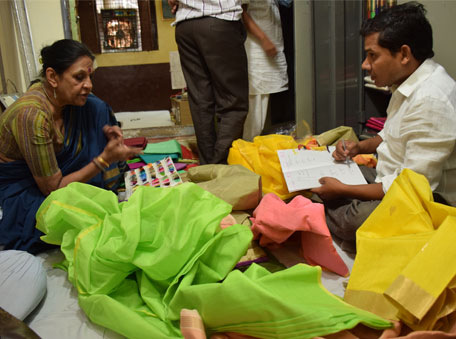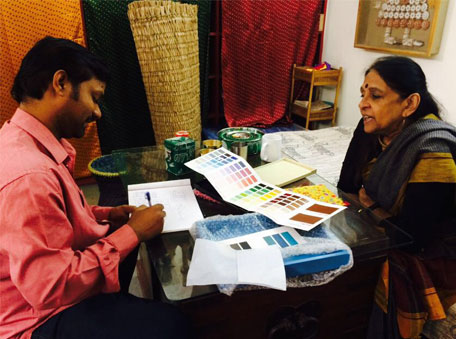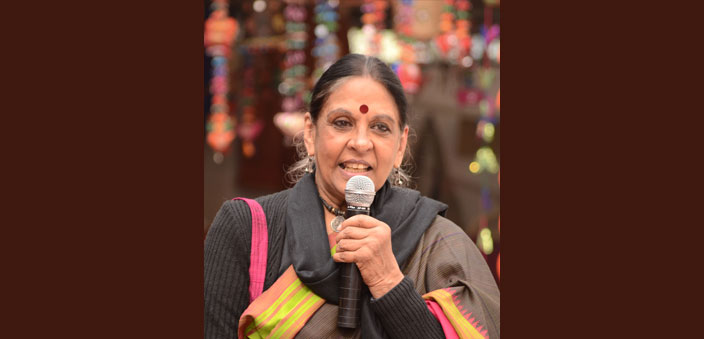What drew you to Indian handicrafts and what have your efforts been at promoting it all these years? Is there a particular state or area of art that you have focused on?
Since the age of eight I have responded to artistic things which surrounded me in Japan, where I lived at that time. I was always excited when I saw creative works and my aesthetic senses kept being sharpened by arts, crafts and textiles of a heritage nature. My roots are in South India, so those influences are strong, but then I became closely associated, first with the crafts of Jammu & Kashmir for many years, and then Gujarat. After intensive work in these states, it gave me a sound understanding that helped me work with crafts people in many skills from all over the country.
Some of the cultural ambassadors in India have shown great concern about our dying art and neglect of Indian artisans. Has this concern translated into concerted effort in promoting our artisans?
Those who have been sincerely involved have become ambassadors because they have propagated their knowledge and concerns across the country and the world. I do not believe someone is a true ambassador if they keep harping on the neglect angle alone. Many negatives can be turned into positives if one works closely with people and skills, being inspired by them, as well as developing their potential and providing a good platform for them.

Every class of society has more options for mobility today, so it should not surprise us that artisans too are part of this flux. However, wherever they have been given or seized opportunities to excel and earn with greater recognition and respect, they not only continue with their traditional occupations, but they innovate and do very well. Who has a stable income today, except government servants? Everything else seems to depend on that inevitable word “market” these days.
Are the states and the Centre doing enough to promote art and artisans? What can be done further to preserve our traditional art and support the artisans to reach the end user by eliminating the middlemen?
The states do less unless large sections of crafts persons can influence votes, put pressure with demands or the state has always been dependent or sensitive to their concerns. Issues like cultural heritage and craft livelihoods have mattered in Jammu & Kashmir, Madhya Pradesh, Rajasthan, Odisha and Andhra Pradesh. In other states it is sporadic or almost nil in terms of effectiveness, no matter how many schemes and statistics exist on paper.
The centre formulates a variety of schemes to encourage design, training, marketing etc., but somehow their implementation usually leaves much to be desired. Once there is a proper assessment of the capability and credibility of NGOs and other institutions, they should be more proactive in making them partners in implementing projects and programmes, insisting on transparency and outside evaluation, but making the work more people friendly, rather than creating endless paper work and red tape.
Urgent areas are facilitating access to raw material and wider markets. Once processes of production are simplified and opportunities for sales and orders increase, design, training, finance and quality improvement fall into place automatically.
Not all middlemen are exploiters and the more direct access to markets or online sales can be achieved by artisans, the role of middlemen will reduce. After all, online marketing websites often mark up craft products from the artisan considerably. In this day and age, would we call them middlemen?
We have many talented designers in India who have launched their apparel brands. Do we have enough designers who recognise the need to work with rural artisans and promote them?
There are many more designers doing so, now that they have been sensitised and have realised the value of “Indianness” which is delving into India’s craft skills and resources, and not just being “ethnic”, which limits its outreach. The term “ethnic” itself has more colonial than contemporary connotations.

Has there been a replication of successful concepts like the Delhi Haat? What are the success areas and success stories? Can you narrate a few?
Inspite of Dilli Haat’s standards and aspirations having fallen over the years through bad administration, it is still successful and popular among both crafts people and visitors. Other haats, both in Delhi and other cities like Jaipur, Bhopal, Ahmedabad, Bhubaneshwar among others, came up as imitators of the concept, without the effort or ability to manage them in a manner that served its true purpose. Government always has good intentions, but bad implementation, since most projects get bogged down in red tape, initially to create system and prevent misuse, but ends up being unimaginative and bureaucratic.
Any haat can be perked up if good crafts persons are brought there and a vibrant mela-like atmosphere created to provide the ambience. Funnily enough, despite the success of Dilli Haat and everyone knowing it was my concept and effort that made it happen, no one has come and asked me to guide them on how to set up a haat and run it successfully! Private bodies and governments of other countries have, but not our own.
The Government of Maharashtra has recently announced its plan to set up a Mumbai Haat, exclusively to market products made by women self-help groups. This would include handicrafts, jewellery, clothes, eatables and households items at Metro Cinema subway, Dhobi Talao. What do you think about this initiative?
I am happy to hear this from you, and support any initiative to provide a decent space for small creative livelihoods to prosper. The agencies involved should first decide whether the occupants will be small traders or producers. If the latter, they must ensure that traders do not take over posing as producers. There should be inclusive and rotational systems of occupancy. Also, it cannot just become another messy marketplace, but must have an upgraded ambience through attractive décor, greenery, cultural performances, clean street food etc., so that it becomes a contemporary version of a heritage activity, reinventing the traditional haat of villages.
Can you tell us about your project – The Hastakala Academi and its objectives? When will it start functioning? How will this initiative help our artisans?
The proposal I gave for a Hastkala Akademi is very close to my heart as it is meant to gather information and be a resource centre for all cultural aspects that surround and give rise to every craft, art and textile practice and object. In India, each craft has a meaning and a use. We are tending to lose this which makes it become just a commercial product without a story that adds cultural and economic value to it. Our traditional heritage, skills, techniques and expressions are amazing and so varied. Unless we collect, document, digitise, exhibit and disseminate these, we will lose ourselves to the underside of globalisation, which eliminates our own cultural identity.
The Indian traditional wear – the sari is going out of fashion. The younger generation seems to find the jeans more convenient. What has been the impact of # 100 Saripact? Has it helped in luring our young women to this wonderful garment?
I do not think the sari is going out of fashion for the majority of Indian women who wear it as their basic form of dress, rather than as a fashion statement. Let’s not only talk about women in cosmopolitan cities. We all wore jeans, salwar kurtas and lehengas in the South when we were young and in our teens. In adulthood and with motherhood, most culturally rooted Indian women wear saris on a regular basis. The younger generation follow a herd mentality and prefer skinny fit jeans in the heat with impossibly high heels. They may look nice, but they can hardly call it convenient or comfortable.
The #100 sari pact certainly put the focus on saris and encouraged many city women and those abroad to take note and enjoy wearing them. Some of us are working together on following up the #100 sari pact with special events in spreading awareness about handlooms, infinite design possibilities, the sheer beauty of a sari and the grace we feel when wearing them, and getting support from these sari converts so that we can do more work among weavers to ensure continuation of livelihoods. I love this field of work because there is always so much new stuff to do. One is constantly being inspired.
Are you happy with the response you got for your book Woven textiles of Varanasi? Are there any new books on handicrafts in the pipeline?
I have written so many books on handicrafts and textiles that I have called a halt! I hope many have seen my book on the Woven Textiles of Varanasi. Actually, I am keen on visitors to Varanasi reading it so that they get another facet of the charm and fame of Varanasi, along with the Ganga and temples.

